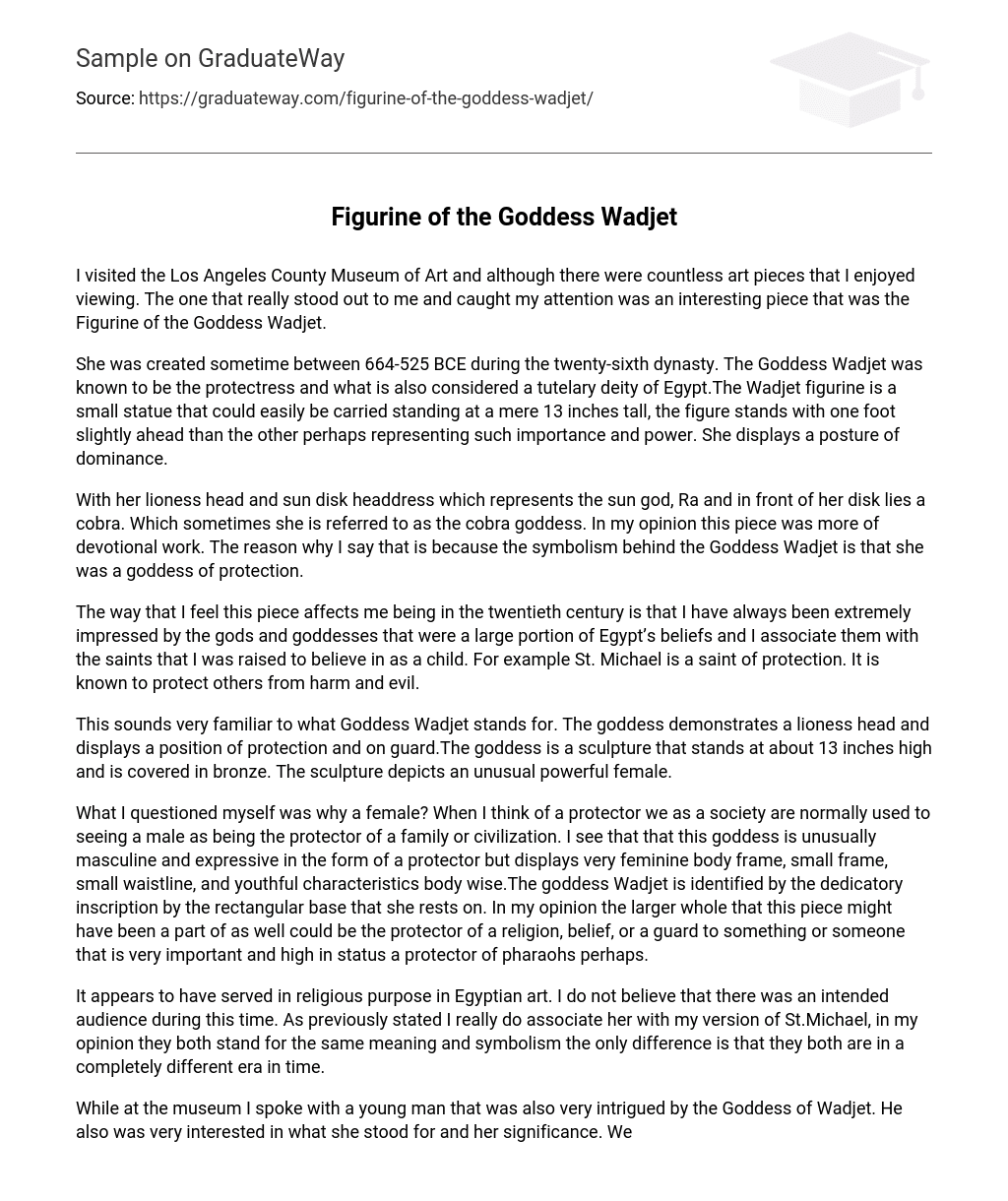While exploring the Los Angeles County Museum of Art, I encountered an array of art pieces. Among them, one particular piece caught my eye and distinguished itself from the others – it was the Figurine of the Goddess Wadjet.
The Goddess Wadjet, created during the twenty-sixth dynasty between 664-525 BCE, is known as the protectress and tutelary deity of Egypt. Standing at a height of 13 inches, the Wadjet figurine is a small statue that can be easily carried. With one foot slightly ahead of the other, the figure projects importance and power, showcasing a posture of dominance.
The Goddess Wadjet is depicted with a lioness head and sun disk headdress, symbolizing the sun god Ra. A cobra lies in front of her disk, giving her the title of the cobra goddess. In my opinion, this artwork serves as a devotional piece due to the symbolism of Goddess Wadjet being a protector deity.
The impact of this piece on my perception as a 20th-century individual is that I have constantly been deeply fascinated by the deities of ancient Egypt, which were integral to their religious beliefs. I draw a parallel between these gods and goddesses and the saints I was taught to believe in during my childhood. A specific example is St. Michael, who is revered as a protective saint safeguarding others from harm and malevolence.
This reminds me of the symbolism associated with Goddess Wadjet. She is depicted with a lioness head, symbolizing protection and vigilance. The bronze sculpture of the goddess is approximately 13 inches tall, showcasing a remarkable portrayal of a strong and formidable female figure.
The question I posed to myself was why a female? Typically, society expects males to serve as the protectors of families and civilizations. However, this goddess defies expectations by embodying both masculine and expressive traits as a protector, while also possessing a feminine body frame with a small waistline and youthful characteristics. The goddess Wadjet can be identified by an inscription on the rectangular base upon which she rests. Personally, I believe that this piece may have been part of a larger whole that served as the protector of a religion, belief, or high-ranking individual, such as a pharaoh.
It appears that in Egyptian art, this object served a religious purpose and did not have a specific target audience. As mentioned earlier, I personally associate it with my interpretation of St. Michael. In my perspective, both of them hold the same meaning and symbolism, differing only in the historical eras they originate from.
While visiting the museum, I engaged in a conversation with a fellow enthusiast who shared my intrigue for the Goddess of Wadjet. Together, we contemplated the significance and symbolism behind her existence. Our dialogue prompted us to contemplate the target audience she was intended for. In my perspective, it appeared improbable that she was crafted for public display. If that were so, she would have likely been portrayed on a grander scale and prominently featured in various other Egyptian artworks. The petite nature of her depiction implies that she might have been designed for private usage, possibly serving as a personal guardian deity for the pharaohs.
As a historian, I can comprehend the significance of Goddess Wadget’s portrayal as a protector through her lioness headdress and the cobra adorning it, which gives her a more aggressive image. Furthermore, during the 26th dynasty, I can appreciate the importance that she once held. Notably, she embodies a distinct feminine figure, emphasized by the discernible outline of her body beneath the delicate veil on which she is seated.
This piece had a profound impact on me, and I was astonished by how discussing it with a stranger increased my fascination with Egyptian art. It is evident that Egyptian culture revolved extensively around religion. They revered numerous gods and goddesses, each holding their own distinct importance. What intrigued me the most was that she was also referred to as the serpent goddess, explaining why she adorned a cobra on her headdress.
The Goddess of Wadjet, whose sacred animal was a cobra, was believed to have her image in jars also containing the sacred cobras. During my visit to the museum, I discovered the diverse fascination that Egyptian art held for people through conversations with various individuals. Personally, I found this subject intriguing and would certainly delve deeper into learning about the Goddess of Wadjet.
As mentioned before, the concept she represents is very similar to what St. Michael represents to me, but in a different era. I have now learned that the various gods and goddesses depicted in Egyptian art have different symbols and meanings, but all represent both good and bad.
Depending on the beliefs held by the Egyptians at that time, I find it imperative to emphasize the stunning beauty, commanding authority, and exquisite grace embodied by the Goddess of Wadget. Simultaneously, she exemplified the beauty and elegance associated with a goddess. Revered as a deity safeguarding Lower Egypt, the Los Angeles County Museum was previously unexplored territory for me. However, thanks to this assignment, I can genuinely declare that it marks the genesis of a burgeoning fascination with Egyptian Art and the Egyptian civilization.





